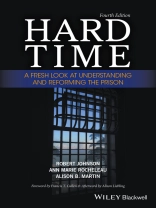Hard Time: A Fresh Look at Understanding and Reforming the Prison, 4th Edition, is a revised and updated version of the highly successful text addressing the origins, evolution, and promise of America’s penal system.
* Draws from both ethnographic and professional material, and situates the prison experience within both contemporary and historical contexts
* Features first person accounts from male and female inmates and staff, revealing what it’s actually like to live and work in prison
* Includes all-new chapters on prison reform and on supermax correctional facilities, including the latest research on confinement, long-term segregation, and death row
* Explores a wide range of topics, including the nature of prison as punishment; prisoner personality types and coping strategies; gang violence; prison officers’ custodial duties; and psychological, educational, and work programs
* Develops policy recommendations for the future based on qualitative and quantitative research and evidence-based initiatives
Tabela de Conteúdo
Foreword xi
Acknowledgments xvii
1 Crime, Prison, and the Case for Corrections 1
A Predilection for Prisons 4
Prison America 6
Incarcerating men and women of color 7
No escaping prison 9
The goals of prison punishment 12
A Case for Decent Prisons 16
Decent prisons and mature coping 17
General dynamics of adjustment 21
Decent prisons as a human right 23
Notes 25
References 30
2 Modern Prisons in Historical Context 35
American Prisons before the Penitentiary 35
Penitentiaries 37
Models of reformative penitentiary quarantine 39
Women and minorities in the penitentiary 41
The southern plantation prison 42
Reformatories 44
The Big House 47
Women and minorities in the Big House 48
The Big House: repression and its discontents 49
The decline of the Big House 52
The Correctional Institution 53
Models of correctional facilities 55
Prison violence 58
Deinstitutionalization and the increase in mentally ill inmates 61
Supermax prisons 62
Notes 65
References 71
3 The Pains of Modern Imprisonment 76
Pain Amelioration in Prisons: Three Stages 77
Living with Deprivation 79
Loss of liberty 79
Deprivation of autonomy 81
Deprivation of goods and services 83
Boredom 85
Deprivation of heterosexual contact 87
Missing family 90
Disrespect 93
Deprivation of security 96
Pain and Harm 99
Notes 103
References 107
4 Prisoner Deficits and Immature Coping 111
Immature Coping 112
Limited cognitive and interpersonal skills 112
Denial 113
Poor self-control 114
Defective socialization 115
Lack of empathy 119
Prisoner Types 120
Predatory convicts 120
State-raised convicts 121
Institutionalized inmates 122
The mentally ill 124
Exceptions to immature coping: Square johns and long-termers 126
Dysfunctional Adaptations to Imprisonment 128
Reconciling Public and Private Inmate Cultures 130
Notes 133
References 138
5 The Public Culture of the Prison: Violence 144
The Nature of Violent Prisoners 146
Predatory convicts and state-raised youth 148
Gang violence 150
Hypermasculinity in prisons 152
Fear, street culture, and the campaign for respect 154
The mentally ill 159
The Nature of Violent Prisons 161
Violence exacerbated by prison administration and conditions 162
Relationships between inmates and officers 163
Situational Violence 166
ANote on Violence in Women’s Prisons 169
Notes 172
References 177
6 The Private Culture of the Prison: Living in Prison 182
Living in Prison 183
A day in a life in prison 185
The Ecology of Prison Survival 189
Prison Life, Prison Niches 194
Types of prison niches 197
Coping Strategies for Living in Prison 209
General coping strategies 209
Coping adaptations unique to prison 210
Coping strategies for lifers and long-termers 212
More Than Survival 216
Notes 219
References 225
7 Correctional Officers’ Public Custodial Agenda 230
Correctional Officer as Hack 231
The persistent image 231
Prevalence of correctional officer violence 234
Nature of prohibited correctional officer violence 236
Nature of prison-sanctioned correctional officer violence 240
Correctional practices that breed violence 244
Stress, Alienation, and Burnout 250
Dimensions of alienation 252
Causes of stress in the prison workplace 258
Notes 261
References 266
8 Prison Officers’ Private Correctional Agenda 271
Providing Human Service 271
The nature of human service 272
Typology of correctional officers as agents of care 275
Human Service Activities 277
Goods and services 277
Referrals and advocacy 278
Helping prisoners adjust and solve problems 279
Rule Enforcement as Human Service Work: Developing Relationships and Legitimacy 282
Collaboration in Helping 286
Human Service in Perspective 291
Notes 294
References 298
9 Supermax and the Overuse of Solitary Confinement 303
Living and Working in Supermax 304
Assessing the Efficacy of the Supermax Experiment 311
Do supermax prisons meet their goals? 311
Supermax as a shelter and a place to pause 314
Some Failures of Supermax 315
Getting into supermax 316
Contributing to a cycle of violence 323
Deterioration of mental health 327
Supermax as anti-rehabilitation and anti-public safety 329
Moving Forward: The Devil Is in the Details 330
Notes 335
References 341
10 Reform 346
Smarter Punishment, Better Prisons 348
Reforming prison ecology 350
Prison programs and the cultivation of mature coping 363
Getting Out and Staying Out 372
Transitional support 373
Reconciliation 377
Notes 379
References 387
Afterword 397
Index 400
Sobre o autor
Robert Johnson is a Professor of Justice, Law and Criminology at American University, Washington, D.C., and Editor and Publisher of Bleak House Publishing. His publications include Death Work: A Study of the Modern Execution Process, which won the Outstanding Book Award of the Academy of Criminal Justice Sciences.
Ann Marie Rocheleau is an Associate Professor at Stonehill College, Easton, Massachusetts. She collaborated on research studies on adult and juvenile corrections, community policing, and drug purchase for the National Institute of Justice and the Office of National Drug Control Policy.
Alison B. Martin is a Policy Analyst with the Council of State Governments Justice Center. She is the co-author of Rights and Responsibilities of Citizenship the World Over and Gay and Lesbian Communities the World Over.
The book includes a Foreword by Francis T. Cullen, Professor of Criminal Justice and Sociology at the University of Cincinnati and an Afterword by Alison Libeling, University Lecturer and Director of the Prisons Research Centre at the Cambridge University Institute of Criminology.












